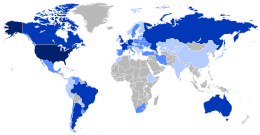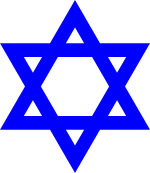Еврей үндэһэтэн
Еврейшүүд (иврит: יְהוּדִים, ISO 259-2: Yehudim, Израиль хэлэлгэ: [jehuˈdim]) гү, али Еврей арад болбол этношажанай бүлгэм[10] үндэһэтэн[11][12], ба түүхэн Израиль ба Иудеягай Израилитууд[13][14][15] ба Ивритуудһаа[16][17] гаралтай. Еврейн үндэһэтэнэй хамаа, национальность, ба шажан нь хоорондоо нягта холбоотой,[18][19] ушариинь Иудаизм нь Еврей арадай үндэһэнэй шажан, болобошье түүнэй сахилга шангаһаа үгы хүрэтэр хубилгадаг.[20][21]
יְהוּדִים (Yehudim) | |
|---|---|
Давидай Одон, Еврей арадай ниитын һүлдэ тэмдэг | |
Ниитэ хүн зон | |
14.6–17.8 сая Ехэдхэһэн хүн зон (бүрин гү, али  | |
Түблэрһэн газар орон | |
| 6,558,000–6,958,000[1] | |
| 5,700,000–10,000,000[1] | |
| 453,000–600,000[1] | |
| 391,000–550,000[1] | |
| 290,000–370,000[1] | |
| 180,000–330,000[1] | |
| 172,000–440,000[1] | |
| 116,000–225,000[1] | |
| 113,000–140,000[1] | |
| 93,000–150,000[1] | |
| 69,000–80,000[1] | |
| 50,000–140,000[1] | |
| 47,000–100,000[1] | |
| 40,000–50,000[1] | |
| 30,000–52,000[1] | |
| 29,000–40,000[1] | |
| 28,000–41,000[1] | |
| 19,000–25,000[1] | |
| 18,000–26,000[1] | |
| 17,000–25,000[1] | |
| 15,000–21,000[1] | |
| 15,000–25,000[1] | |
Хэлэн аялгуу | |
| |
Шажан | |
Түрэл арад түмэн | |
Еврейн үндэһэтэнэй хубаалга (Ашкенази, Сефард ба Мизрахим) Семит-хэлэтэй хүнүүд: Самаришууд,[3][4][5] Арабууд[4][6][7][8] Ассиришууд[9] ба Левантшууд[4][8][5] Бусад | |
Зүүлтэ
Заһаха- ↑ 1,00 1,01 1,02 1,03 1,04 1,05 1,06 1,07 1,08 1,09 1,10 1,11 1,12 1,13 1,14 1,15 1,16 1,17 1,18 1,19 1,20 1,21 1,22 Dashefsky, Arnold; Della Pergola, Sergio; Sheskin, Ira, eds. (2018). World Jewish Population (PDF) (Report). Berman Jewish DataBank. Retrieved 22 June 2019.
- ↑ Links. Beth Hatefutsoth.
- ↑ Kiaris, Hippokratis (2012). Genes, Polymorphisms and the Making of Societies: How Genetic Behavioral Traits Influence Human Cultures. Universal Publishers. ISBN 978-1-61233-093-8.
- ↑ 4,0 4,1 4,2 (September 2004) «Reconstruction of patrilineages and matrilineages of Samaritans and other Israeli populations from Y-Chromosome and mitochondrial DNA sequence Variation». Human Mutation 24 (3): 248–260. doi:10.1002/humu.20077. PMID 15300852.
- ↑ 5,0 5,1 Ridolfo, Jim (2015). Digital Samaritans: Rhetorical Delivery and Engagement in the Digital Humanities. University of Michigan Press. ISBN 978-0-472-07280-4.
- ↑ Wade, Nicholas. "Studies Show Jews' Genetic Similarity", The New York Times, 9 June 2010
- ↑ (December 2000) «High-resolution Y chromosome haplotypes of Israeli and Palestinian Arabs reveal geographic substructure and substantial overlap with haplotypes of Jews». Human Genetics 107 (6): 630–641. doi:10.1007/s004390000426. PMID 11153918.
- ↑ 8,0 8,1 Jews Are The Genetic Brothers Of Palestinians, Syrians, And Lebanese. Sciencedaily.com (9 May 2000).
- ↑ (June 2010) «Abraham's Children in the Genome Era: Major Jewish Diaspora Populations Comprise Distinct Genetic Clusters with Shared Middle Eastern Ancestry». The American Journal of Human Genetics 86 (6): 850–859. doi:10.1016/j.ajhg.2010.04.015. PMID 20560205.
- ↑ Эшэ татахада гараһан алдуу: Неверный тег
<ref>; для сносокJews-are-ethnoreligious-groupне указан текст - ↑ Эшэ татахада гараһан алдуу: Неверный тег
<ref>; для сносокNicholson2002не указан текст - ↑ Эшэ татахада гараһан алдуу: Неверный тег
<ref>; для сносокDowty1998не указан текст - ↑ Raymond P. Scheindlin (1998). A Short History of the Jewish People: From Legendary Times to Modern Statehood. Oxford University Press, 1–. ISBN 978-0-19-513941-9. Israelite origins and kingdom: "The first act in the long drama of Jewish history is the age of the Israelites"
- ↑ Facts On File, Incorporated (2009). Encyclopedia of the Peoples of Africa and the Middle East. Infobase Publishing, 337–. ISBN 978-1-4381-2676-0. "The people of the Kingdom of Israel and the ethnic and religious group known as the Jewish people that descended from them have been subjected to a number of forced migrations in their history"
- ↑ Harry Ostrer MD (2012). Legacy: A Genetic History of the Jewish People. Oxford University Press, 26–. ISBN 978-0-19-997638-6.
- ↑ "In the broader sense of the term, a Jew is any person belonging to the worldwide group that constitutes, through descent or conversion, a continuation of the ancient Jewish people, who were themselves descendants of the Hebrews of the Old Testament." Jew at Encyclopædia Britannica
- ↑ "Hebrew, any member of an ancient northern Semitic people that were the ancestors of the Jews." Hebrew (People) at Encyclopædia Britannica
- ↑ Eli Lederhendler (2001). Studies in Contemporary Jewry: Volume XVII: Who Owns Judaism? Public Religion and Private Faith in America and Israel. Oxford University Press, 101–. ISBN 978-0-19-534896-5. "Historically, the religious and ethnic dimensions of Jewish identity have been closely interwoven. In fact, so closely bound are they, that the traditional Jewish lexicon hardly distinguishes between the two concepts. Jewish religious practice, by definition, was observed exclusively by the Jewish people, and notions of Jewish peoplehood, nation, and community were suffused with faith in the Jewish God, the practice of Jewish (religious) law and the study of ancient religious texts"
- ↑ Tet-Lim N. Yee (2005). Jews, Gentiles and Ethnic Reconciliation: Paul's Jewish identity and Ephesians. Cambridge University Press, 102–. ISBN 978-1-139-44411-8. "This identification in the Jewish attitude between the ethnic group and religious identity is so close that the reception into this religion of members not belonging to its ethnic group has become impossible."
- ↑ (1997) Jewish Survival: The Identity Problem at the Close of the Twentieth Century; [... International Workshop at Bar-Ilan University on the 18th and 19th of March, 1997]. Transaction Publishers, 90–. ISBN 978-1-4128-2689-1. "A person born Jewish who refutes Judaism may continue to assert a Jewish identity, and if he or she does not convert to another religion, even religious Jews will recognize the person as a Jew"
- ↑ A Portrait of Jewish Americans (1 October 2013). “But the survey also suggests that Jewish identity is changing in America, where one-in-five Jews (22%) now describe themselves as having no religion.”
